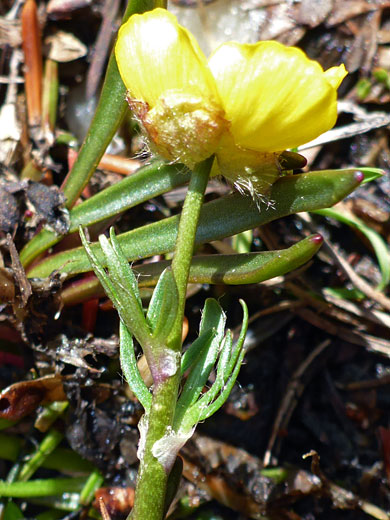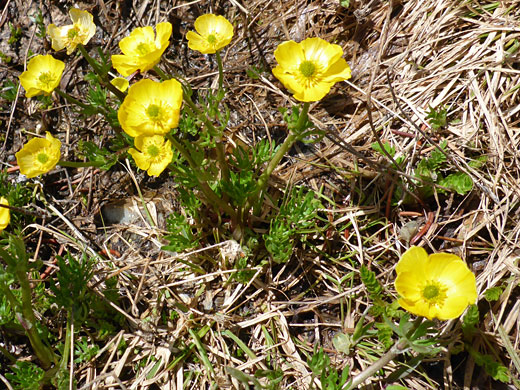Common name:
Alpine buttercup
Family:
Scientific name:
Ranunculus adoneus
Main flower color:
Range:
Nevada, Utah, Idaho and Wyoming
Height:
Up to 10 inches
Habitat:
Moist meadows, from 8,000 to 14,000 feet
Leaves:
Approximately round, up to 1 inch across, divided several times into narrow, linear segments
Season:
May to September
Ranunculus adoneus is a high elevation species, usually found in short grass meadows near the edge of melting snow; it is most widespread in the Rocky Mountains of Colorado and Wyoming, with smaller occurrences in Idaho, northern Utah and eastern Nevada.
Leaves are relatively small and are divided two or three times into linear lobes, round-pointed at the tip. Leaves grow at the base and at wide intervals along the stem, often just one pair. Stems are hairless, quite thick, erect or ascending, and are topped by one (usually) to three flowers, which are larger than the leaves, up to 1.5 inches in diameter.
Flowers have between five and ten yellow, wedge-shaped petals, and five shorter, greenish-yellow sepals, which have white hairs on the lower surface. Sepals are broad at the tip. The flower is cup-shaped; petals are overlapping, and curved up towards the tip. The outer edges of the petals are slightly irregular.
Leaves are relatively small and are divided two or three times into linear lobes, round-pointed at the tip. Leaves grow at the base and at wide intervals along the stem, often just one pair. Stems are hairless, quite thick, erect or ascending, and are topped by one (usually) to three flowers, which are larger than the leaves, up to 1.5 inches in diameter.
Flowers have between five and ten yellow, wedge-shaped petals, and five shorter, greenish-yellow sepals, which have white hairs on the lower surface. Sepals are broad at the tip. The flower is cup-shaped; petals are overlapping, and curved up towards the tip. The outer edges of the petals are slightly irregular.
All Contents © Copyright The American Southwest | Comments and Questions | Contribute | Site Map



